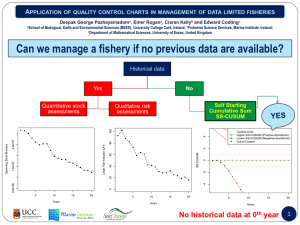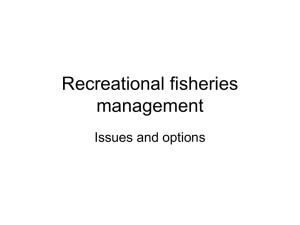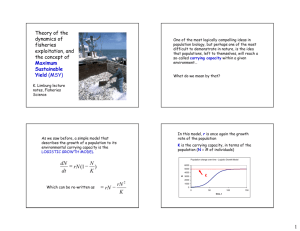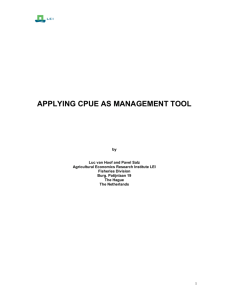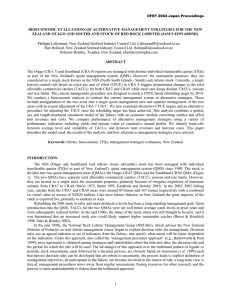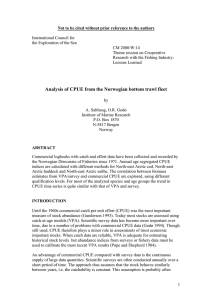Task 3 - Body Text for CPUE WCGBTS Maps
advertisement
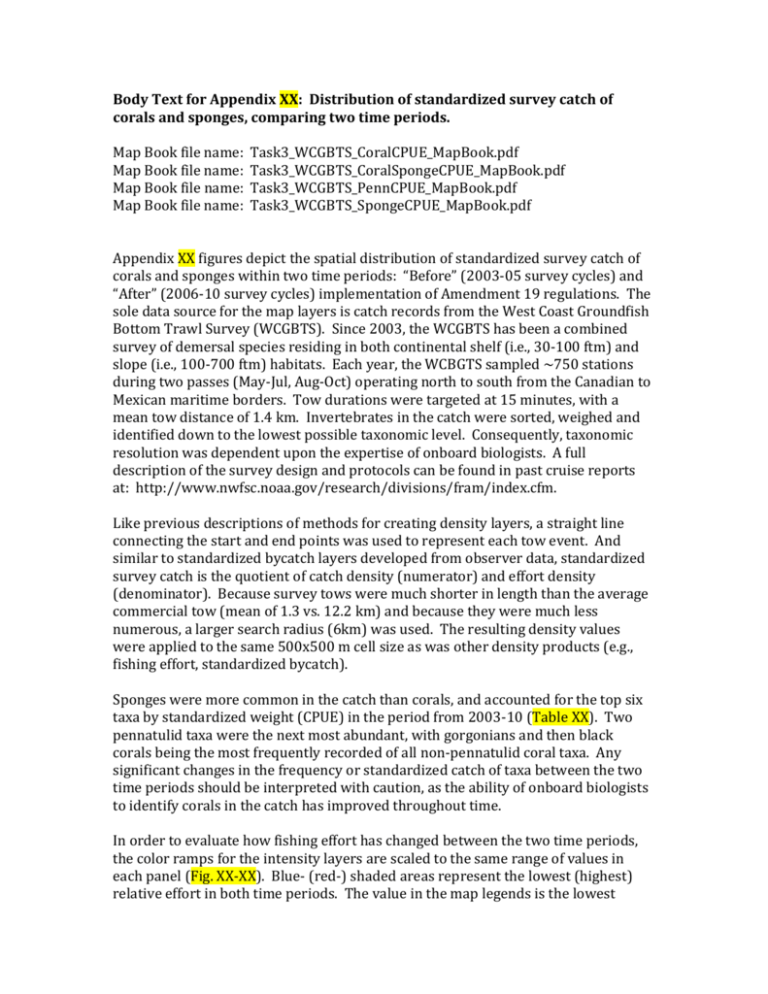
Body Text for Appendix XX: Distribution of standardized survey catch of corals and sponges, comparing two time periods. Map Book file name: Map Book file name: Map Book file name: Map Book file name: Task3_WCGBTS_CoralCPUE_MapBook.pdf Task3_WCGBTS_CoralSpongeCPUE_MapBook.pdf Task3_WCGBTS_PennCPUE_MapBook.pdf Task3_WCGBTS_SpongeCPUE_MapBook.pdf Appendix XX figures depict the spatial distribution of standardized survey catch of corals and sponges within two time periods: “Before” (2003-05 survey cycles) and “After” (2006-10 survey cycles) implementation of Amendment 19 regulations. The sole data source for the map layers is catch records from the West Coast Groundfish Bottom Trawl Survey (WCGBTS). Since 2003, the WCGBTS has been a combined survey of demersal species residing in both continental shelf (i.e., 30-100 ftm) and slope (i.e., 100-700 ftm) habitats. Each year, the WCBGTS sampled ~750 stations during two passes (May-Jul, Aug-Oct) operating north to south from the Canadian to Mexican maritime borders. Tow durations were targeted at 15 minutes, with a mean tow distance of 1.4 km. Invertebrates in the catch were sorted, weighed and identified down to the lowest possible taxonomic level. Consequently, taxonomic resolution was dependent upon the expertise of onboard biologists. A full description of the survey design and protocols can be found in past cruise reports at: http://www.nwfsc.noaa.gov/research/divisions/fram/index.cfm. Like previous descriptions of methods for creating density layers, a straight line connecting the start and end points was used to represent each tow event. And similar to standardized bycatch layers developed from observer data, standardized survey catch is the quotient of catch density (numerator) and effort density (denominator). Because survey tows were much shorter in length than the average commercial tow (mean of 1.3 vs. 12.2 km) and because they were much less numerous, a larger search radius (6km) was used. The resulting density values were applied to the same 500x500 m cell size as was other density products (e.g., fishing effort, standardized bycatch). Sponges were more common in the catch than corals, and accounted for the top six taxa by standardized weight (CPUE) in the period from 2003-10 (Table XX). Two pennatulid taxa were the next most abundant, with gorgonians and then black corals being the most frequently recorded of all non-pennatulid coral taxa. Any significant changes in the frequency or standardized catch of taxa between the two time periods should be interpreted with caution, as the ability of onboard biologists to identify corals in the catch has improved throughout time. In order to evaluate how fishing effort has changed between the two time periods, the color ramps for the intensity layers are scaled to the same range of values in each panel (Fig. XX-XX). Blue- (red-) shaded areas represent the lowest (highest) relative effort in both time periods. The value in the map legends is the lowest “high” value between the time periods. It was necessary to set the color ramp to the lowest “high” value in order for the colors in each panel to perfectly match and therefore be comparative. In the maps showing standardized catch of corals excluding sea pens/whips (Fig. XX-XX), areas of highest relative CPUE occurred off northern California (Map 3) in both time periods. Two areas off northern Washington show moderate CPUE, one within the Olympic 2 EFH conservation area in the recent time period. In the maps showing sponges only (Fig. XX-XX), the areas of highest relative CPUE occurred off southern California, two sites in the before period and one in the after (Map 7). The one area of highest CPUE in the recent time period also showed relative moderate catches of sponges in the before period. Other areas of moderate catch of sponges occurred near the Eel River Canyon (Map 4, before) and off central Oregon in both time periods (Map 2). Areas of highest CPUE for sea pens/whips (Fig. XX-XX) occurred off northern and central Oregon (Map 2) and central California (Map 7). Other areas of moderate CPUE are apparent off San Francisco in the recent time period (Map 5) and central (Map 7) and southern California (Map 8 and 9). One important consideration when evaluating catch records of invertebrates from trawl surveys is the sampling gear itself. Bottom trawl gear used in the WCGBTS is not designed to sample sessile invertebrates, nor is it designed to access many of the preferred habitats for coral and sponge settlement. Regardless of the limitations of the gear, corals or sponges were recorded in almost half of all survey tows (see Table XX). Recall that survey tows are much shorter in duration than commercial tows, and vessel captains can often prosecute a tow in areas where they normally wouldn’t during commercial operations. This may in part account for the fact that corals and sponges are recorded more frequently in survey catches (see Appendix XX, Table XX [WCGOP documentation]). Table XX. Summary of coral and sponge taxa recorded during tows as part of the West Coast Groundfish Bottom Trawl Survey (WCGBTS), comparing two time periods: “Before” (2003-05) and “After” (200610). “#” denotes number of tows with recorded bycatch; “FREQ” denotes ratio of tows with catch to total tows recorded; “CPUE” denotes catch per unit of effort (units: kg/ha). Tow counts represent only those where corals or sponges were present in the catch. Taxa are listed in descending order of CPUE for combined time period. Taxon # Porifera 359 Hexactinosida 103 Rossellinae 53 Suberites spp. 3 Hyalonema spp. 47 Hexactinellida 17 Pennatulacea 245 Anthoptilum grandiflorum 98 Chrysopathes spp. 0 Antipatharia 66 Halipteris spp. 0 Gorgonacea 58 Anthomastus ritteri 16 Ptilosarcus gurneyi 28 Alcyonacea 14 Anthomastus spp. 19 Callogorgia kinoshitae 4 Umbellula spp. 23 Paragorgia spp. 6 Isidella spp. 1 Scleractinia 4 Farrea spp. 5 Anthoptilum murrayi 4 Flabellidae 2 Caryophylliidae 1 Bathypathes spp. 6 Keratoisis spp. 2 Stylasteridae 1 Lillipathes spp. 3 Callogorgia spp. 1 Pennatula phosphorea 1 Acanthogorgiidae 0 Combined 749 Total Hauls /Time Period 1,652 BEFORE AFTER BEFORE + AFTER FREQ CPUE # FREQ CPUE # FREQ CPUE 21.7% 1,852.90 647 19.0% 2,297.41 1,006 19.9% 4,150.31 6.2% 810.13 295 8.7% 2,371.76 398 7.9% 3,181.89 3.2% 154.01 91 2.7% 698.79 144 2.8% 852.80 0.2% 425.77 9 0.3% 2.90 12 0.2% 428.67 2.8% 49.17 95 2.8% 174.32 142 2.8% 223.49 1.0% 77.80 0 0.0% 0.00 17 0.3% 77.80 14.8% 16.18 417 12.3% 24.44 662 13.1% 40.62 5.9% 6.64 289 8.5% 30.58 387 7.7% 37.22 0.0% 0.00 31 0.9% 29.24 31 0.6% 29.24 4.0% 23.85 25 0.7% 1.77 91 1.8% 25.61 0.0% 0.00 161 4.7% 13.11 161 3.2% 13.11 3.5% 2.56 82 2.4% 10.34 140 2.8% 12.90 1.0% 3.09 69 2.0% 8.04 85 1.7% 11.13 1.7% 2.48 62 1.8% 5.64 90 1.8% 8.12 0.8% 0.89 15 0.4% 3.53 29 0.6% 4.42 1.2% 3.00 11 0.3% 1.29 30 0.6% 4.29 0.2% 0.06 22 0.6% 4.09 26 0.5% 4.15 1.4% 1.38 94 2.8% 2.47 117 2.3% 3.84 0.4% 0.56 14 0.4% 2.68 20 0.4% 3.24 0.1% 0.06 9 0.3% 3.05 10 0.2% 3.11 0.2% 2.43 3 0.1% 0.14 7 0.1% 2.57 0.3% 0.76 3 0.1% 0.85 8 0.2% 1.61 0.2% 0.06 29 0.9% 1.01 33 0.7% 1.07 0.1% 0.03 9 0.3% 0.82 11 0.2% 0.84 0.1% 0.09 5 0.1% 0.35 6 0.1% 0.45 0.4% 0.05 25 0.7% 0.37 31 0.6% 0.42 0.1% 0.41 0 0.0% 0.00 2 0.0% 0.41 0.1% 0.00 4 0.1% 0.37 5 0.1% 0.37 0.2% 0.08 9 0.3% 0.20 12 0.2% 0.28 0.1% 0.02 4 0.1% 0.17 5 0.1% 0.19 0.1% 0.01 10 0.3% 0.10 11 0.2% 0.12 0.0% 0.00 1 0.0% 0.01 1 0.0% 0.01 45.3% 3,434.45 1,554 45.7% 5,689.85 2,303 45.5% 9,124.30 3,404 5,056

